
From its very beginning in 1963, the Polynesian Cultural Center has featured traditional canoes and, soon after opening, launched a canoe pageant that remains an important part of our daily program. The canoes and pageant not only pay tribute to the islanders’ ancient legacy of incredible migrations and blue-ocean way-finding or navigation, but also provide a most unique display of Polynesian entertainment.
“Today, other places in Hawaii have stages on the water,” said Delsa Atoa Moe, Polynesian Cultural Center Director of Cultural Presentations, “but as far as we know they’re all anchored. We’re the only one using actual canoes that move with groups of performers aboard.”
Of course, historical Polynesian Cultural Center photos from over 50 years ago show a lot has changed from those early days when a small number of Polynesian Cultural Center musicians boarded a full-size Samoan canoe, complete with pandanus-mat sail, and serenaded guests while cruising along the lagoon.
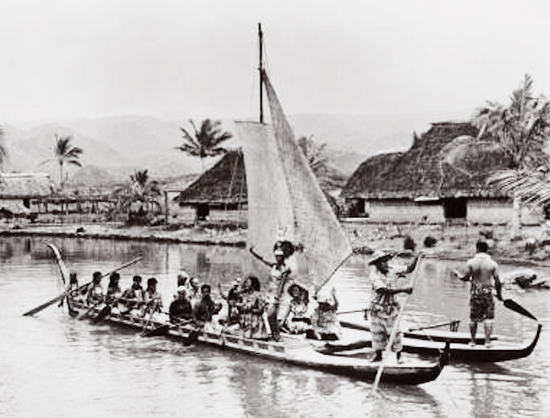
Here are a few other facts and stories you might not have known about the Polynesian Cultural Center’s canoe legacy and pageant:

The 40-man waka taua or war canoe in the Maori Village was originally begun with the intention of presenting it as a gift for England’s King George VI, who died before it was completed. When news that the Polynesian Cultural Center was being built in Hawaii reached New Zealand, tribal leaders around Kaikohe agreed to finish the waka taua for the PCC.
Skilled artisans have carved some of the canoes at the Polynesian Cultural Center, including the three-man Samoan va’aalo (bonito fishing) outrigger out of a rare piece of Hawaiian koa wood.
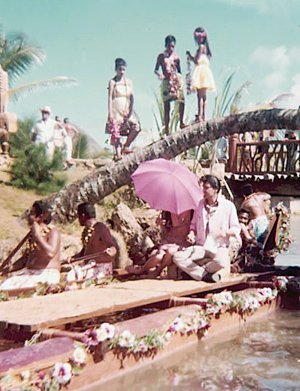
Elvis Presley, the “king” of rock-and-roll, included a canoe segment and other shots in his movie, Paradise Hawaiian Style, that he filmed at the Cultural Center in June 1965. (For some extra fun, click on the picture above to see a video clip of Elvis AND the Polynesian Cultural Center’s staff singing, dancing and having a blast in “Paradise Hawaiian Style”!)
The guy pushing the Samoan canoe in the pageant has been falling off — to the delight of the audience — from day-one. Similarly, when she was a student performer, Moe remembers she enjoyed dancing on the Tahitian canoe:
“There was a little platform about two steps above the deck where the solo dancer would perform. It’s one thing to dance and shake on the canoe deck, but it was different when we were balancing on that little platform. Sometimes the paddler would try to get us to lose our balance. Plus, we had to end our solos just in time to duck down when the canoe went under the bridges. It was a fun challenge.”
In 1975 when the Polynesian Voyaging Society was first creating its now-famous Hokulea sailing canoe, they asked the Polynesian Cultural Center for some help weaving a traditional hut on the deck. Three Samoan guys from PCC did the work at Kualoa.
The music, choreography, costumes, titles and themes change occasionally, but the Polynesian Cultural Center canoe pageant format is still very popular.
We used to put special decorations on each island’s canoe that was celebrating a special event or national holiday.
As crowds grew over the years, the Polynesian Cultural Center began putting the pageant on at several places along the lagoon so more people could enjoy better seating.
Moe recalls, “At one point, we were putting the pageant on in four different locations: One between Hawaii and Tahiti, one by the Maori Village, one by the Samoan Village, and a Japanese-language one by the theater. We built speakers into each canoe to minimize the challenge of synching the sound.”
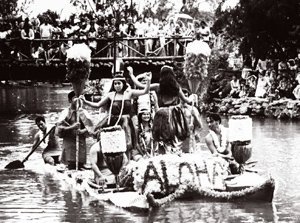
In the early 1980s, the Polynesian Cultural Center commissioned the late Hawaiian artist Herb Kawainui Kane to design a fleet of traditional Polynesian canoes, one for each village. Kane completed the commission, and a double-hulled Tongan kalia — where the smaller hull acts as an outrigger — was actually built. It was moored by the Polynesian Cultural Center’s Tongan Village for a number of years; but, unfortunately, it was too big to pass under the various bridges across the Polynesian Cultural Center lagoon at that time.
Consequently, none of the other designs were ever built.
Also during the 1980s we started Voyages of the Pacific, where canoes from one village would travel to another village, be greeted with traditional protocol, and observe traditional visitor/reception ceremonies.
In 1985 the Polynesian Cultural Center commissioned carvers on the Fijian island of Kabara in the Lau Archipelago to create a 40-foot traditional ocean-going camakau or outrigger canoe using only natural materials.
It’s still on display in the PCC’s Fijian Village. About that same time, the Polynesian Cultural Center dug out its original stage in the Hale Aloha, and extended the lagoon. “It turned out very nicely,” Moe said. “The water bubbled out of a spring right in the middle of the new ‘stage.’ There wasn’t much room, so each canoe would only turn around once or twice, but we could put the pageant on there four times a day without interrupting village programs.”
About that same time, the Polynesian Cultural Center dug out its original stage in the Hale Aloha, and extended the lagoon. “It turned out very nicely,” Moe said. “The water bubbled out of a spring right in the middle of the new ‘stage.’ There wasn’t much room, so each canoe would only turn around once or twice, but we could put the pageant on there four times a day without interrupting village programs.”
“The theater speakers were mounted into the mouth of a huge tiki-motif feature of the backdrop, and the company that did it won an award for their creativity in disguising the speakers.”
The pageant, however, eventually returned to the regular lagoon, the water-stage was refilled, and the Hale Aloha has ultimately been remodeled into the Polynesian Cultural Center’s premier Alii Luau venue.
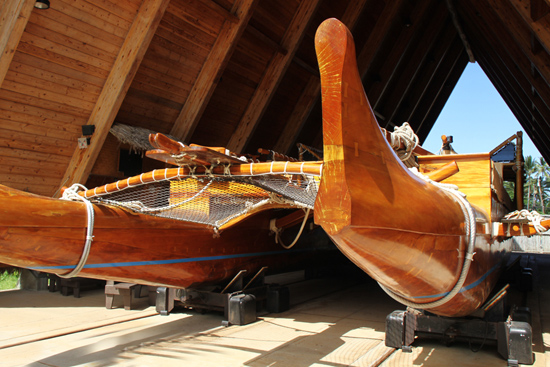 In 2001 master carvers created the Iosepa, a 57-foot traditional twin-hulled Hawaiian sailing canoe for the BYUH Hawaiian Studies program. In 2007 private donations made it possible to build a hālau wa’a or facility for the Iosepa — when it’s not sailing — in the Polynesian Cultural Center’s Hawaiian Village. The A-framed “berth” was completed about a year later, and now permanently houses the Iosepa.
In 2001 master carvers created the Iosepa, a 57-foot traditional twin-hulled Hawaiian sailing canoe for the BYUH Hawaiian Studies program. In 2007 private donations made it possible to build a hālau wa’a or facility for the Iosepa — when it’s not sailing — in the Polynesian Cultural Center’s Hawaiian Village. The A-framed “berth” was completed about a year later, and now permanently houses the Iosepa.
For a number of years the Polynesian Cultural Center put on special Halloween-themed frightening canoe rides after regular hours, and also more traditionally themed Christmas canoe rides; but both of these special events have since been discontinued.
Several years ago Polynesian Cultural Center launched its Canoe Race activity, where small groups can experience island-style canoe riding — and racing, for those of a mind — for themselves.
Today, a cast of almost 50 student performers puts on the Polynesian Cultural Center canoe pageant each afternoon, Monday-Saturday, simultaneously at 2:30 p.m. in two locations: between Hawaii and Tahiti, and on the lagoon by Samoa. It’s still a great show.
You can view clips of this beautiful pageant by clicking on the picture below:

Mike Foley, who has worked off-and-on
at the Polynesian Cultural Center since
1968, has been a full-time freelance
writer and digital media specialist since
2002, and had a long career in marketing
communications and PR before that. He
learned to speak fluent Samoan as a
Mormon missionary before moving to Laie
in 1967 — still does, and he has traveled
extensively over the years throughout
Polynesia and other Pacific islands. Foley
is mostly retired now, but continues to
contribute to various PCC and other media.

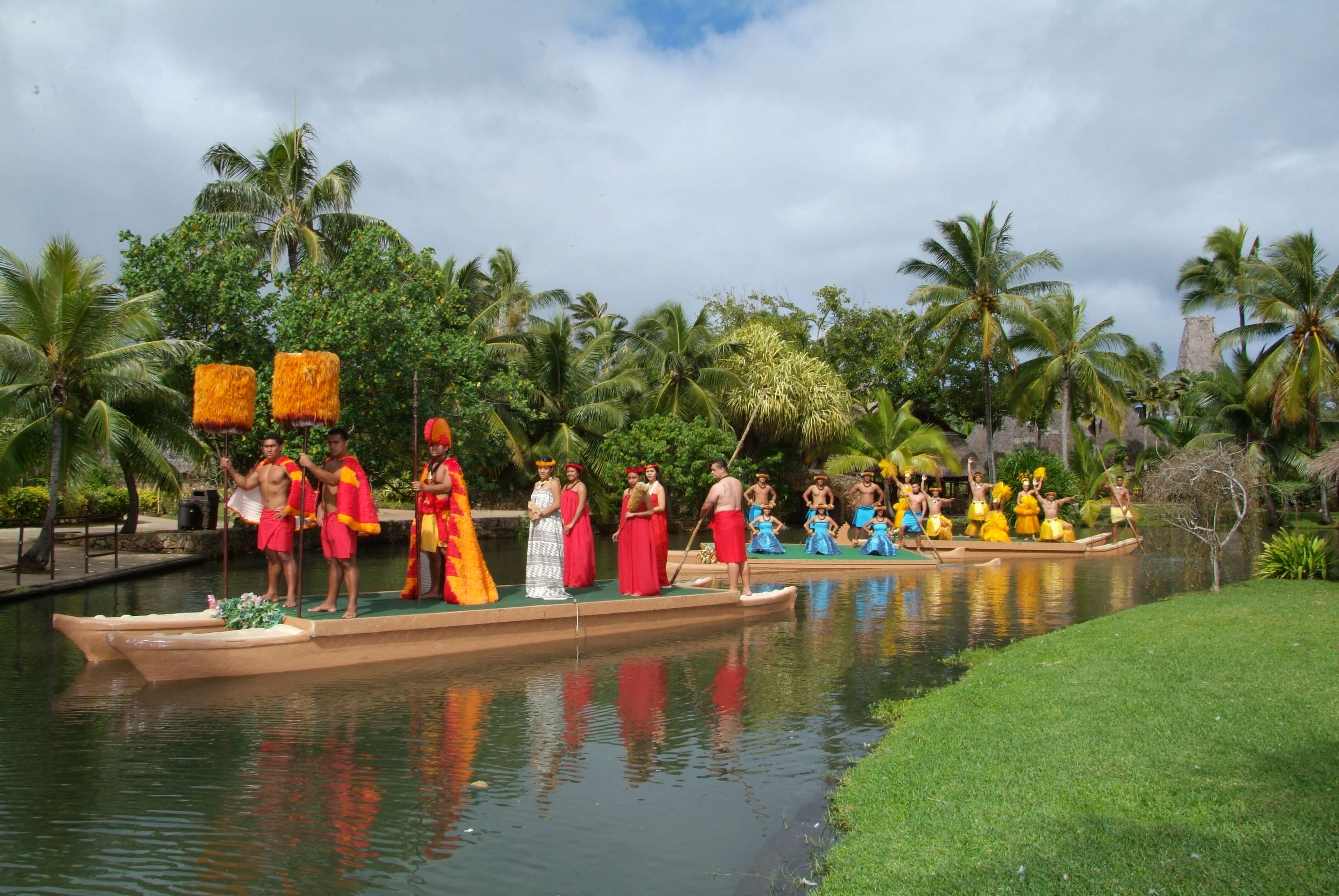
Recent Comments